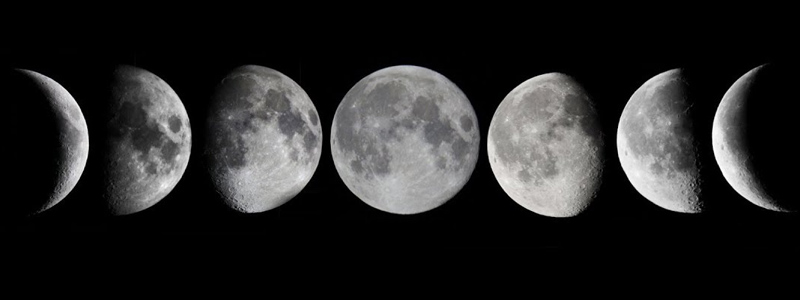Why do lunar eclipses only occur during a full moon and solar eclipses during a new moon?
Table of Contents
Answering this question requires a knowledge of both the cause of lunar phases and the cause of eclipses.
Lunar Phases
As the Moon orbits the Earth it appears to change shape in its monthly cycle of phases. The Moon’s shape of course remains spherical. What changes is the portion of the Moon that we see that is lit up by the Sun? To help visualize why we see phases, use a flashlight, globe, and tennis ball (or reasonable approximations) to represent the Sun, Earth, and Moon.
The Sun lights up half of the Moon, which on its monthly orbit shows us varying amounts of the light and dark portions of its surface. We see phases. When the Moon is directly opposite the Sun in the sky, we see all the bright half and none of the dark half – a full Moon. The new Moon is directly between Earth and Sun so that we see none of the bright-half of the Moon.

The quarter phases are halfway between the new and full Moon with the Moon ninety degrees from the Sun, as seen from Earth. The quarter phase between the new and full Moon, when the Moon is waxing, is the first quarter. The quarter phase between the full and new Moon, when the Moon is waning is the third quarter. These quarter phases are often incorrectly called the “half-moon” because we see half of a circle.
The crescent phases occur between the new Moon and the quarter moon phases. We see a thin crescent shape. During the waxing crescent phase, the Moon is brightening from the new Moon to the first quarter. That is the crescent Moon we see low in the western sky just after sunset. The waning crescent phase is visible low in the eastern sky just before dawn as the Moon goes from the third quarter to the new Moon.
The gibbous phases have a shape between a half and a full circle. The waxing gibbous phase occurs between the first quarter and the full Moon. After the full Moon, we see the waning gibbous phase.
The phases in order are: new Moon, waxing crescent, first quarter, waxing gibbous, full moon, waning gibbous, third quarter, and waning crescent.
Eclipses
Keep that flashlight, globe, and tennis ball handy. Place the tennis ball between the flashlight and the globe so that its shadow falls on the globe. This shows the configuration of a solar eclipse. The Moon’s shadow falls on the Earth. Note that this can only occur when the Moon is between the Earth and the Sun, which is the configuration for the new Moon. That is why a solar eclipse can occur only during the new Moon. We don’t have a solar eclipse every new Moon because the north-south alignments of the Sun and Moon must match. Otherwise, the Moon’s shadow is above or below the Earth, as occurs most months.
Now put the tennis ball on the other side of the globe, so that the globe’s shadow falls on the tennis ball. This is the configuration for a lunar eclipse when the Earth’s shadow falls on the Moon. Notice that this is also the configuration for the full Moon. Hence we can only have a lunar eclipse during the full Moon. As for the solar eclipse, the north-south alignments must match or we have the Earth’s shadow falling above or below the Moon. So we don’t have a lunar eclipse every full Moon.
